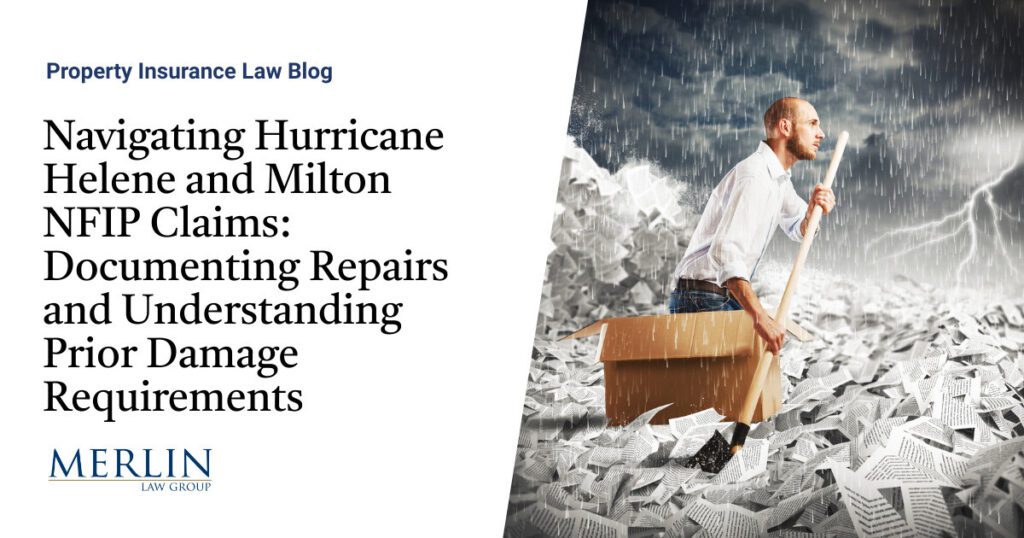Navigating Hurricane Helene and Milton NFIP Claims: Documenting Repairs and Understanding Prior Damage Requirements

Following Hurricanes Helene and Milton, many Florida and southeast residents are left grappling with flood damage – some for the second or third time in recent years. For National Flood Insurance Program (NFIP) policyholders, especially those who have experienced prior flood losses, understanding the documentation requirements for repairs is crucial. I have fielded numerous questions about this topic from public adjusters, restoration contractors and policyholders. This article aims to shed light on these requirements and highlight a federal case that offers a nuanced perspective on the issue. The point of the article is to keep these records or find the old records proving the repairs were made. There are federal requirements to do so, which will impact the smooth handling of a flood claim.
The NFIP’s Stance on Prior Damage
The National Flood Insurance Program has specific guidelines regarding claims for properties with prior flood damage. The Standard Flood Insurance Policy (SFIP) includes a provision, Article VII(H)(2)(e), which allows insurers to request “evidence that prior flood damage has been repaired.”
FEMA and many Write-Your-Own (WYO) insurance companies have interpreted this to mean that policyholders must provide proof of repairs from previous flood losses before they can receive payment for the same damaged items in a subsequent flood. The rationale is to prevent “double dipping” – paying for the same damage twice.
Documentation Requirements
For policyholders who have experienced multiple flood events, maintaining thorough documentation is critical. Here’s what you should keep:
1. Repair Receipts: Keep all receipts for materials purchased and labor costs for repairs.
2. Contractor Statements: Obtain detailed statements from contractors describing the work completed.
3. Before and After Photos: Take clear, dated photographs showing the damage and subsequent repairs.
4. Inspection Reports: If available, keep reports from any inspections done after repairs were completed.
5. Permits: Retain copies of any permits obtained for repair work.
6. Bank or Credit Card Statements: Keep records of payments made for repairs.
7. Correspondence: Save any emails or letters related to the repair process.
A Different Perspective: The Westmoreland Case
While FEMA and many insurers have taken a strict stance on requiring proof of prior repairs, a recent federal case offers a potentially different interpretation of the SFIP. In Joyce Westmoreland v. Fidelity National Indemnity Insurance Company, 1 the federal court took a nuanced view of Article VII(K)(2)(e) of the SFIP.
The court’s key findings include:
1. No Explicit Exclusion: The court noted that Article VII(K)(2)(e) 2 does not explicitly exclude coverage for prior unrepaired damages. It merely provides the insurer with the option to request evidence of repair.
2. Ambiguity in the SFIP: The court found that the SFIP is ambiguous as to its coverage of prior unrepaired damages. In insurance law, ambiguities are typically resolved in favor of the insured.
3. Structural Interpretation: The court pointed out that coverage exclusions are typically found in Articles IV and V of the SFIP, not in Article VII. Neither Article IV nor V excludes coverage for unrepaired prior flood damages.
4. Adjuster’s Role vs. Coverage: The court distinguished between the adjuster’s obligation to exclude unrepaired prior damages from the adjustment (as per the FEMA Adjuster Claims Manual) and the actual scope of coverage under the SFIP.
While this case does not set a binding precedent for all jurisdictions, it offers a compelling argument that the SFIP may not categorically exclude coverage for unrepaired prior damages simply based on a lack of documentation.
Implications for Policyholders
The Westmoreland case potentially opens the door for policyholders to argue for coverage of previously damaged items that were repaired, even if they lack comprehensive proof of repairs. “Potentially” is the key word in this sentence. I do not see any NFIP carrier agreeing to pay for previously damaged property that has not been repaired or replaced. The NFIP carriers will want to see evidence of the damaged property being fixed. Of course, if the damage was previously slight and the new damage is greater than before, I can appreciate a number of cases will arise with this Westmoreland dilemma.
However, it’s crucial to note:
1. Westmoreland is a district court decision and may not be binding in other jurisdictions.
2. FEMA and WYO insurers will continue to require proof of repairs in most cases. I know they are doing so because people are calling me and asking if they can do so.
3. Having thorough documentation of prior repairs remains the best way to ensure smooth claim processing.
If the NFIP carrier denies the claim in whole or part, please consider hiring legal counsel as soon as possible. Being faced with a denial based on lack of proof of prior repairs makes the claim a legal matter. Consider consulting with an attorney experienced in flood insurance claims. The Westmoreland case may provide a basis for challenging such denials.
Navigating NFIP claims, especially with a history of prior flood damage, will be complex. The traditional stance has been to require proof of repairs for previously damaged items, and if you cannot do so, the Westmoreland case suggests there may be room for a more nuanced interpretation of the SFIP.
As always, thorough documentation remains your best tool in the claims process. However, policyholders facing denials based solely on lack of proof of prior repairs may have grounds to challenge these decisions, particularly considering the Westmoreland case. I still believe that if the property was previously damaged and not fixed, it will be almost impossible to prevail. However, the question may be one of the degree of damage that may provide the type of Westmoreland scenario for coverage.
As we continue to face increasing flood risks due to climate change, it’s crucial for policyholders to stay informed, document diligently, and advocate for clear, fair policies that protect their interests while maintaining the integrity of the NFIP. If you did not read yesterday’s post, Modernizing the National Flood Insurance Program: A Call for Higher Coverage Limits, please take a minute to do so. It is an important issue in the property insurance industry.
Thought For The Day
If at first you don’t succeed, then skydiving definitely isn’t for you.
—Steven Wright
1 Westmoreland v. Fidelity National Indem. Ins. Co., No. 13-564 (M.D. La. May 29, 2015).
2 Now, VII.(H)(2)(e).




